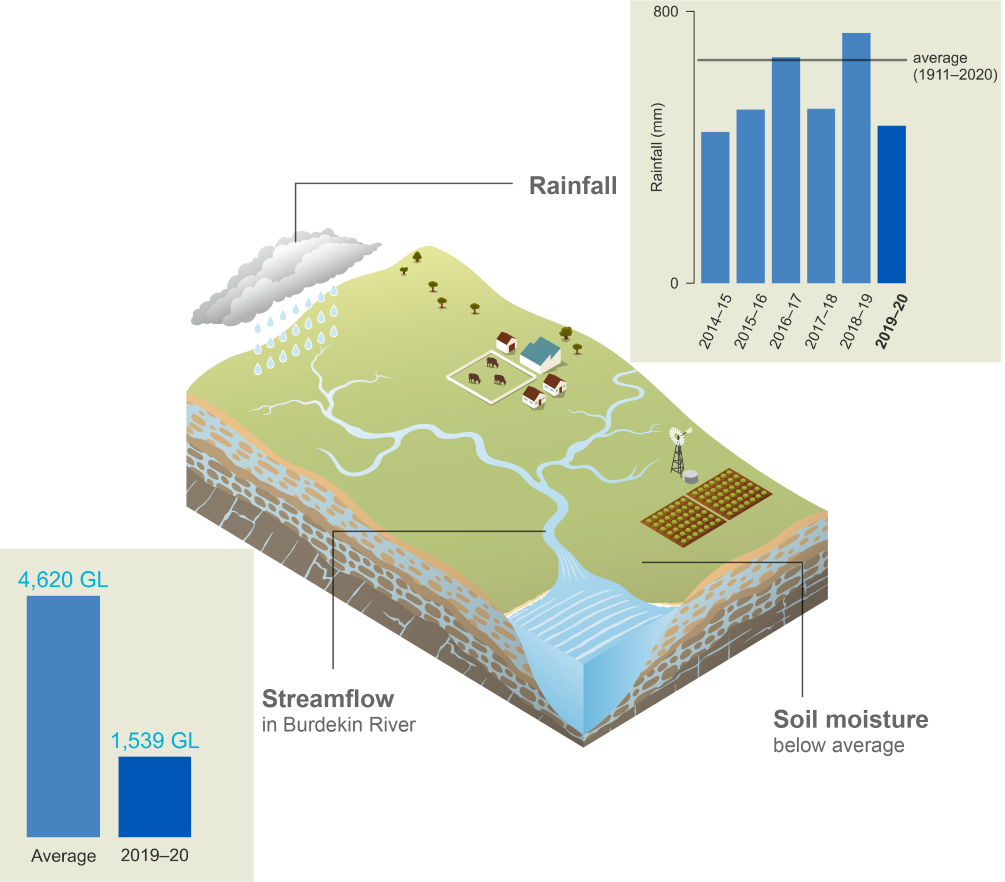Burdekin: Climate and water
- Total annual rainfall was well below average and the lowest in five years.
- The poor wet season rainfall resulted in very low flows in the Burdekin River.

For further information on the region's climate and water conditions during the 2019–20 year scroll down this page or click on the links below:
About the region
- The Burdekin region lies within the dry tropics of northern Australia, which has a distinct and predictable climatic seasonality. As a consequence, flow in the rivers is strongly seasonal.
- Almost all rainfall in the region occurs during the wet season (November–April).
Climate conditions
Rainfall
Figure C1 Annual and monthly rainfall deciles for the Burdekin region during the 2019–20 year
- Total area-averaged rainfall for the year was 464 mm, well below the mean value of 656 mm.
- The transition of the Southwest Indian Monsoon into the southern hemisphere was six weeks later than average and the latest on record. The delayed monsoon period meant very little rainfall occurred across the region at the start of the 2019–20 wet season, which contributed to the below-average annual rainfall.
- A tropical low in the Gulf of Carpentaria and a monsoon trough produced heavy rainfall over the region in late January 2020, which contributed to the above-average rainfall for that month.
- Above-average rainfall in July 2019 was due to showers associated with an upper level trough that impacted the region in mid-July. Above-average rainfall in May 2020 was due to late wet season showers over the region.
Figure C2 Total monthly rainfall for the Burdekin region during the 2019–20 year compared with the average and percentiles for the region
- Rainfall was above average in January 2020; all other wet season months (November–April) had well below-average rainfall.
- Rainfall in December 2019 was the lowest on record for that month.
Actual evapotranspiration
Figure C3 Annual and monthly actual evapotranspiration deciles for the Burdekin region during the 2019–20 year
- Total area-averaged actual evapotranspiration was average to below average across the region.
- Evapotranspiration was well below average during the early part of the wet season (November–January) due to low water availability following the delayed onset of the 2019–20 monsoon period.
- Evapotranspiration was above average over large parts of the region during February and June 2020 following periods of higher rainfall in the preceding months.
Soil moisture
Figure C4 Annual and monthly soil moisture deciles for the Burdekin region during the 2019–20 year
- Soil moisture in the root zone (0–1m depth) was average to below average across the region.
- The delayed monsoon period meant very little rainfall occurred at the start of the 2019–20 wet season. By December 2019, root-zone soil moisture was well below-average and lowest on record in some parts of the region.
- Soil moisture had returned to average to above-average conditions by June 2020 following high rainfall late in the wet season during May 2020.
- More information on soil moisture distribution across the Burdekin region is available in the Australian Landscape Water Balance.
Streamflow responses
Streamflow

Figure C5 Key flow gauging stations along the main rivers within the Burdekin region
- The Burdekin, Cape and Suttor rivers are three primary rivers that flow into Lake Dalrymple, which supports the region's Burdekin Haughton Water Supply Scheme.
- The Bowen River is downstream of Lake Eungella and provides water for the region's Bowen Broken Water Supply Scheme.
Figure C6 Total monthly flow for key rivers during the 2019–20 year compared with the average and percentiles
- Total annual flows in the region's major rivers were well below average. For example, total annual flow in the Burdekin River at Sellheim (Station 120002C) was 1,539 GL compared to the average value of 4,620 GL.
- The above-average rainfall that occurred over the region in January 2020 had only a minor effect on streamflow in these rivers. The very dry conditions during the first half of the wet season following the delayed onset of the monsoon period meant that much of the rainfall that occurred was soaked up by the soil.
- Most of the region's annual flow occurred during January–March 2020. By April 2020, streamflow had returned to very low levels in the major rivers, particularly in the Cape and Suttor rivers where flow had ceased by mid-April 2020.









